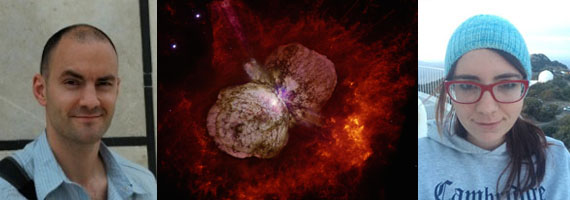
Steward Astronomers Use Trick of Light Echoes to Unravel 19th Century Mystery of a Behemoth Star
Eta Carinae is the most massive and most luminous star known in the Milky Way galaxy. It is famous for its "Great Eruption" that occurred in the mid-19th century, when it brightened for about 20 years to become the second brightest star in the sky, and it is surrounded by a massive dumbbell-shaped nebula that is recognizable from Hubble images. The cause of its giant outburst has remained mysterious since then, although it is the prototype for an entire class of modern transients seen in other galaxies, including some outbursts that immediately precede supernova explosions. A larger image of the Eta Carinae Nebula can be seen HERE.
A team led by UA Professor Nathan Smith and UA Postdoc Dr. Jennifer Andrews, as well as Dr. Armin Rest of the Space Telescope Science Institute, have been using instruments at the Magellan telescope, Gemini South, and other ground-based telescopes to study light echoes from the 19th century eruption of the monster star Eta Carinae. Light echoes are faint reflections of a past event, like a supernova or major stellar eruption, which have bounced off interstellar dust clouds and arrived at Earth after a time delay due to the finite speed of light. Just as an audio echo gives a delayed transmission of the original words shouted across a canyon, light echoes carry the same signatures as the original light from the supernova or stellar outburst. In the case of Eta Carinae and some historical supernovae, the brightening seen at Earth occurred before the invention of the modern astronomical spectrograph, one of the most important tools that astronomers have to dissect the light from stars. The light echoes were discovered by examining changes in brightness in a series of wide-field images obtained with the CTIO 4m telescope, and the faint echoes were then observed with spectrographs on larger telescopes like Magellan and Gemini South. The resulting spectra of the faint light echoes show what astronomers would have seen in the 1840s, if they would have had astronomical spectrographs back then. Light echoes are the next best thing to time travel, if one is interested in studying past explosions. While images reveal how bright a distant object is, spectra can reveal details of gas composition, temperature, density, and speeds of motion via the Doppler shift.
The resulting spectra of light echoes from Eta Carinae's eruption revealed several surprises, the most astonishing of which was Doppler shifts that indicated extremely fast expansion speeds, even faster than seen in typical supernova explosions. This is very surprising for a star that survived the event, and for which most models expect a slow and dense wind during its eruption. Expansion speeds seen in light echoes, however, reached as fast as 10,000 to 20,000 km/s, which is also much faster than the present wind or the expanding nebula seen around the star today (top speeds of only 600 km/s). Altogether, the light echoes paint a picture where a powerful fast explosion crashed into surrounding slow gas, causing the star to brighten for several years as a result of this violent collision, before fading away as it was obscured by the cooling gas and dust from the explosion. Smith and collaborators explain a hypothesis that the violent explosion and the surrounding slow material that it rammed into could have been the result of a violent stellar merger, where two massive stars coalesced together into the monster star that remains today. These results were presented in two papers published by the Monthly Notices of the Royal Astronomical Society HERE and HERE and press releases can be found HERE and HERE. (The text here is by Nathan Smith, thank you.)

For Public
Public events include our Monday Night Lecture Series, world-reknowned Astronomy Camp and Mt Lemmon Sky Center.

For Students
A good place to start if you want to become an undergrad major or grad student, or need to find our schedule of classes.

For Scientists
Find telescopes and instruments, telescope time applications, staff and mountain contacts, and faculty and staff scientific interests.




